Storing books and reading nooks
(And managing the options)
I originally published this post on January 8, 2021. I have massively edited and updated it since then — including photos of what my storage and reading nooks look like now.
I think every family has particular challenges when it comes to reading, be it time, or lack of knowledge about good books, or creating the habit, or a million other things.
Over the nine years since I became a mother, I’ve built our reading life very intentionally (because reading is essential, absolutely indispensable, to me; because growing up I had two parents who devoured books and raised this reader well; because I want my children to be thinking people). Our situation is two parents working full-time outside the home with two young children in full-time school and + wraparound daycare. I’ve spent years thinking through what reading can (and does) look like within that framework — including building reading nooks, the challenges of owning and storing so many books, and more. I’ve learned a lot and tried many things and I offer my experience to that end.
Your own book culture can look however you want it to, be however you want it to be. There are no rules here. My hope is that you find something useful that will make your family’s reading life more enjoyable.
Let’s jump right into something I get asked a lot:
Where do you keep all your books, and how do your kids access them?
I thought this was a simple thing to explain until I started going around my house taking photos for you, and it turns out my best answer is: everywhere. In every room. In all possible places.
In all pairs of photos, the ones on the left were taken in January 2021 — now, 2.5 years later in July 2023, things look different, which you can see on the right. This is my real, lived-in, imperfect home, so you’re seeing what it really looks like on a day I went around and snapped pictures without making any effort whatsoever — everything is usually clean but it’s also frequently messy, because it’s more important to me to have a fruitful family life than an Instagram-perfect home 😉 (That goes for everything in my life, fwiw.)
With that charming lead-in, here’s where I keep all our books and how my kids access them.
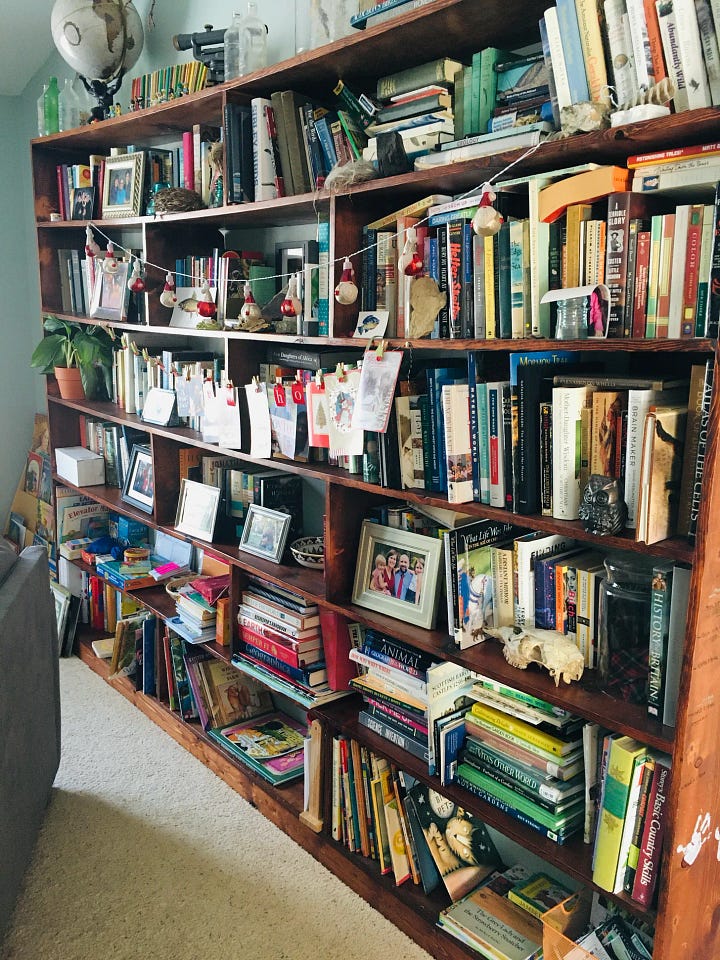

👆🏻 These first shots are in what we call “the front room,” which is dominated by a large, somewhat chaotic bookshelf my husband custom-built for me the second we moved into our house. The children’s books take up (and have always taken up and still take up) all or part of the lower shelves. We store other kids items there too — games, mostly — but it is primarily a place for books.
I used to rotate out the titles here maybe quarterly, but now, never — what I do is pull books from this shelf to put on our front-facing bookcase in the pockets of time between seasons (when I put seasonal and holiday books on that shelf instead). At this point, we have so many books, the density is such that unless I actively pull them and put them in front of my children, they’ll never see them.
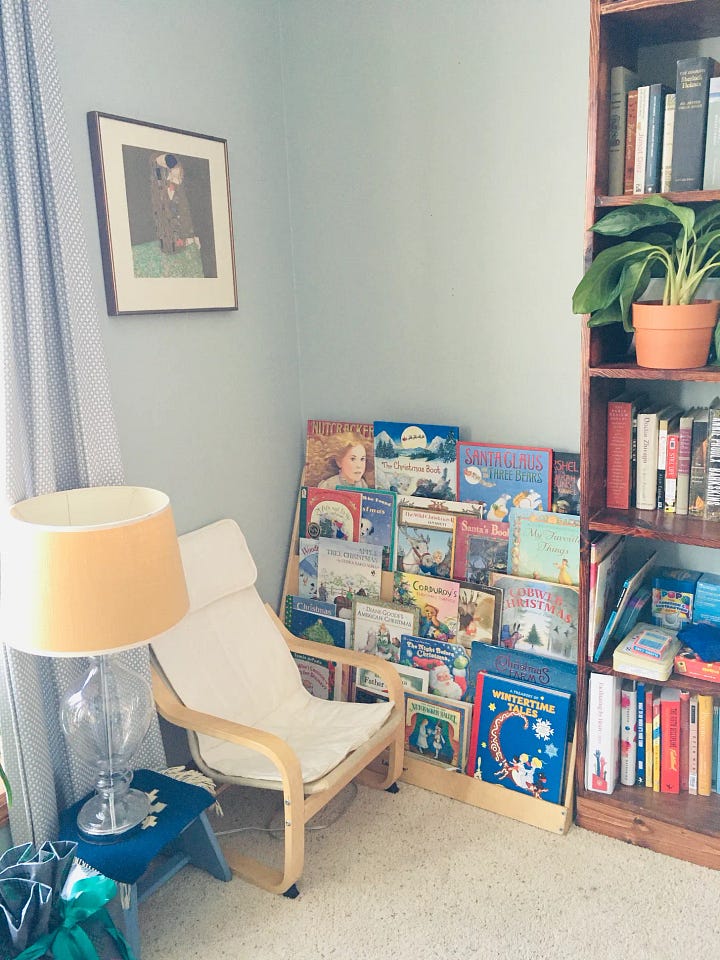
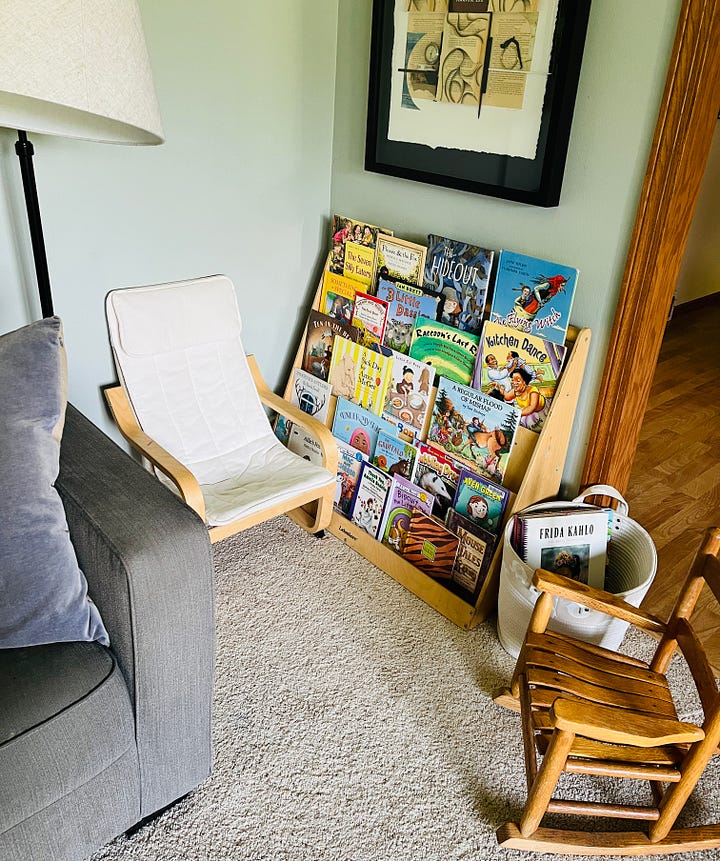
Best access to books = reading nooks
👆🏻 This reading nook is sometimes next to the big bookcase and sometimes on the opposite side of the room.
I bought what’s called the “help-yourself bookstand” on Craigslist (it’s from Lakeshore Learning; it’s worth every penny). Front-facing books are important — kids judge books by their covers just like adults do, so it’s important for pre-readers, reluctant readers (Donalyn Miller calls this category of kids “developing readers” and “dormant readers,” which I just love) and enthusiastic readers alike.
Providing readers with their own spaces is also important: I am a big builder of reading nooks and we’ve had many. All you really need is a light, a comfy seat, and a stack of books, although I’ve found that the cozier you make it, the better. As soon as my eldest could sit up by herself, I laid down a large bathmat in the corner of her room (they tend to be softer, cheaper, and available in more neutral colors than actual rugs), propped some pillows against the wall, and put a small selection of board books in a basket. She spent hours there (that’s 18 minutes in Baby Time).
I rotate the front-facing shelf more often than anywhere else — this is where, overnight, seasonal and holidays books appear (and if a season lasts a long time, e.g., summer, I try to add new ones every couple weeks).
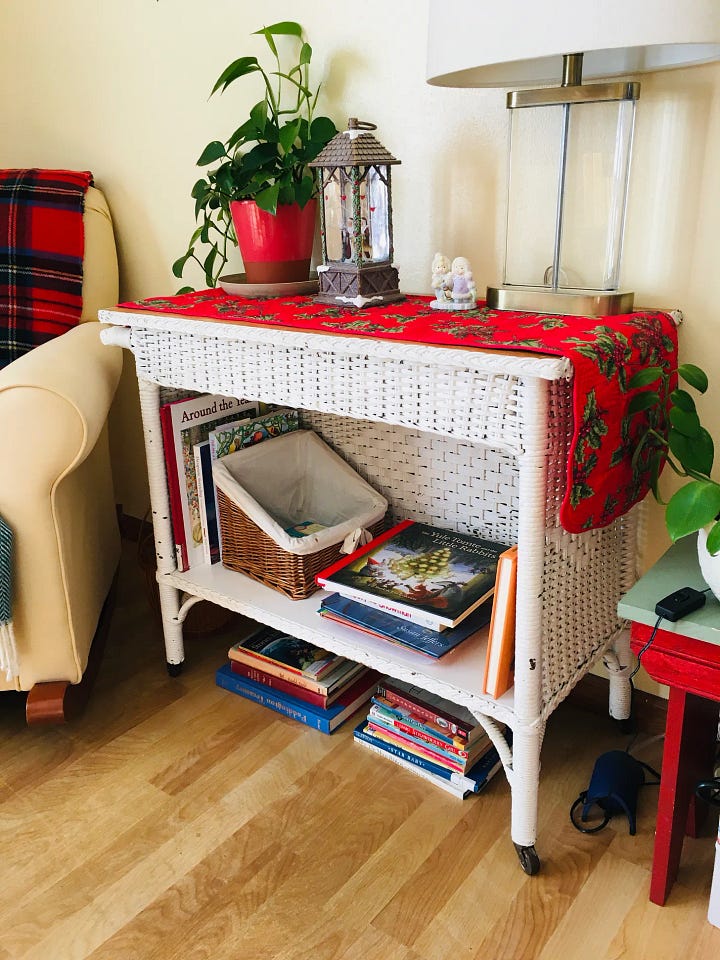

👆🏻 This is a spot in our eat-in kitchen, directly adjacent to our dining table (and next to another reading spot I created, this one also for adults). This is headquarters for what we call Morning Time — a concept I stole from the homeschool world when my first child was old enough to sit upright in a high chair and which I wrote about in my issue on reading routines. Most of the titles in this area get changed out monthly — once a much more thoughtful and planned-out routine, an integral part of our experiment of a year homeschooling, and is now pretty lackadaisical, though I have enough years of experience with Morning Time that it’s probably oodles more intentional than I’m giving myself credit for.
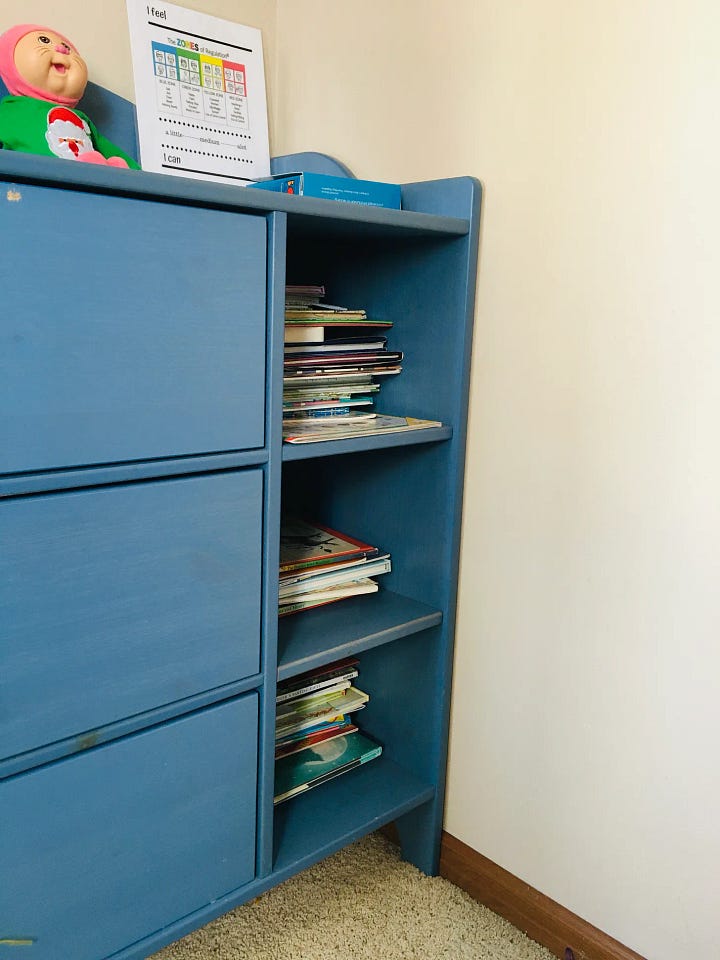
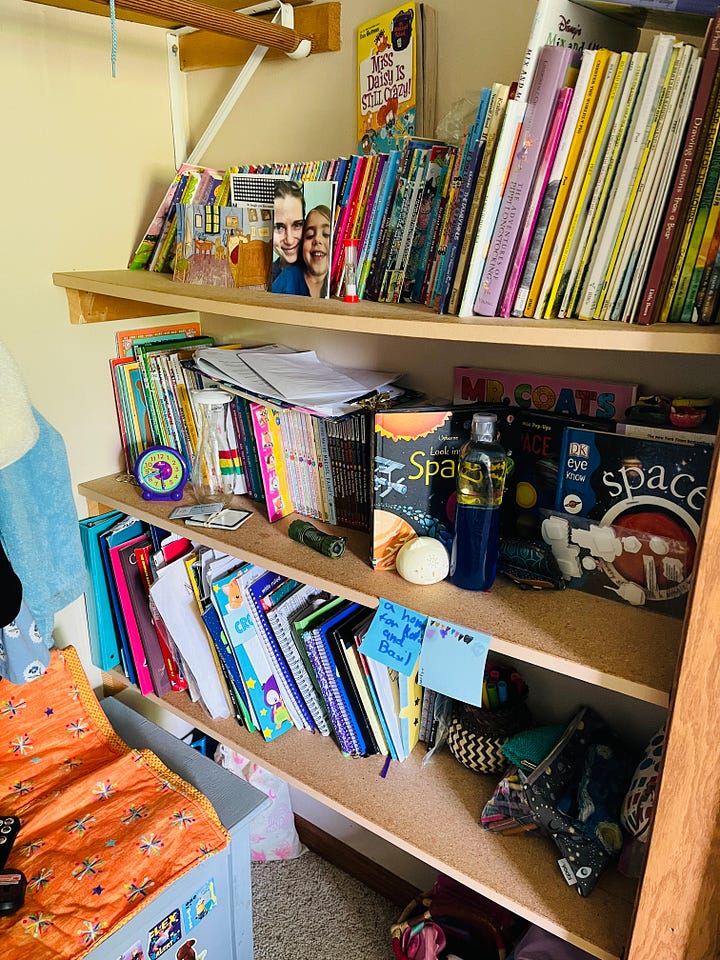
👆🏻 This is the only area in my children’s shared bedroom that has books — it started as a tidy little part of a dresser in their closet and bloomed into this multi-shelf situation that I never touch. This is where my eldest hoards (I use that word intentionally) her favorites and is entirely under her control, which is as it should be. For this reason, I never rotate these titles — sometimes I go digging for one I want to cover in this newsletter but then I return it (I enable the hoarding, as this is what readers do).

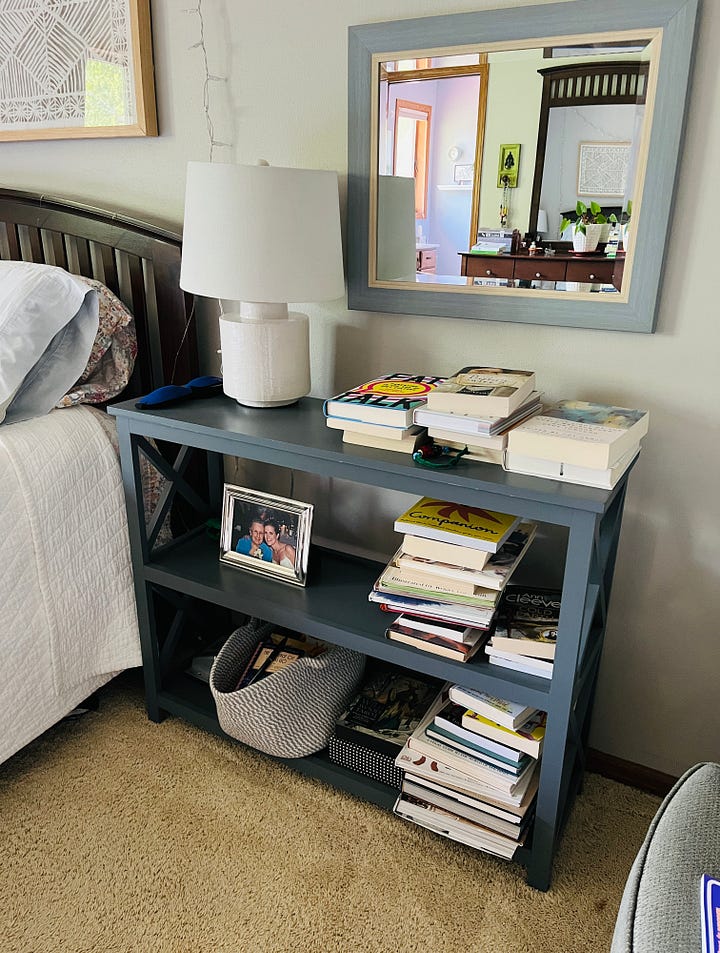
👆🏻 The rule of our bedroom is that children’s things cannot linger; by the time I get into bed I don’t want to see any evidence that the short folks have been here (ask me how that’s going 2.5 years later 😑): the one exception to this is books.
This is my bedside table (I am a bookworm and an increasingly untidy one); sometimes there are children’s books here. We rarely read aloud in this room — at least in the sense of my sitting down and using my voice to communicate the words on the page — but this is a regular spot for reading for my kids.
From the time they could sit on my bed without toppling off (headfirst, WHY always headfirst), I have trained them to spend the time I use getting dressed and ready for work sitting with what I call “looking books,” which I’ve also written an entire issue about. Looking books are not ones that I am going to read — sometimes this means it is every Daniel Tiger, Minnie Mouse, or Disney franchise character book they have checked out of the library, more often it is photography or coffee table books I have provided for them — but rather ones they are going to page through and peruse themselves. This has worked out beautifully over the years: I put my pants all the way on without having to stop for someone else’s needs, they ease into the day at their own pace in a comfortable spot and look at beautiful (sometimes inane) books.
(When they were doing this every single day, I rotated these books every 2-3 weeks to keep it fresh or else this trick didn’t work. Now they almost always bring their own books — and take them away later — so I don’t do anything with these titles anymore.)
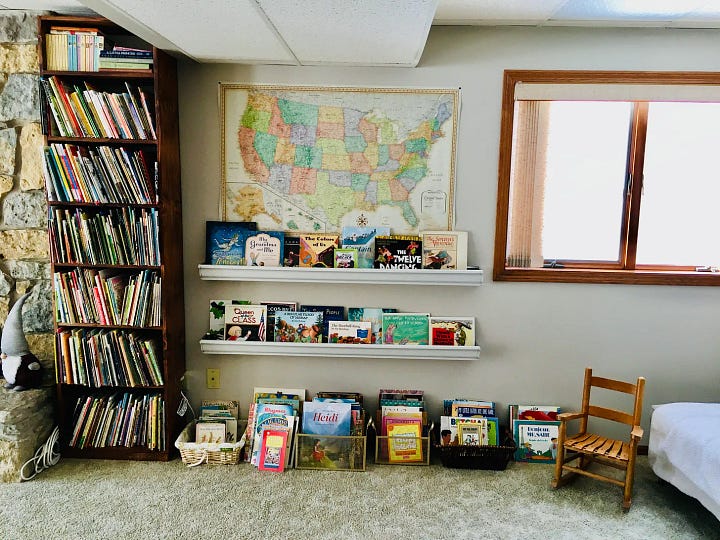
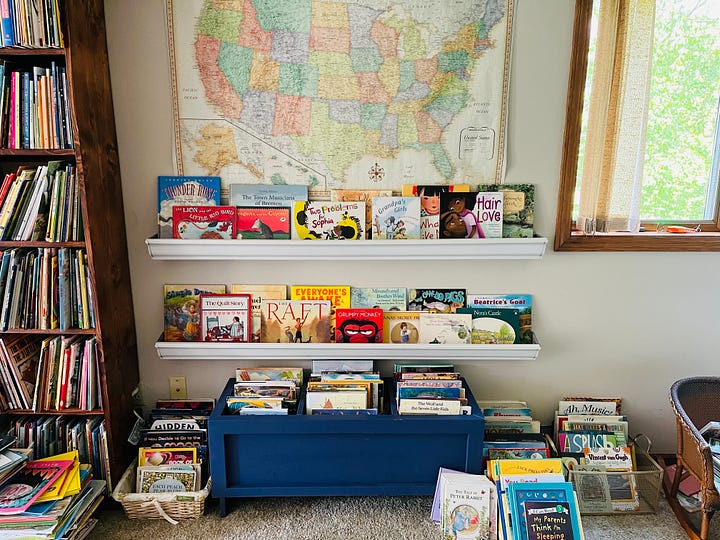
👆🏻 Moving downstairs to the lower level of our house, which is finished but nonetheless has this awkward area set apart from the main space where the previous owners had a full bar (because Wisconsin) and hideous vertical shades that we still (STILL) have not replaced (because laziness + clearly my financial priority is buying books): half of this is a play area and the other, well, this. This is one of two bookshelves (again, custom-built by my husband) where I store some of our children’s books. While I am showing you right now that we have books all over our dang house, there is also no way I’d be able to keep so many without some sort of large area like this. I have never counted how many titles we own, but I am guessing it’s at least 1,000 2,000 (and that’s not including books for adults). Since this really is storage in the traditional sense, I don’t rotate any of the books on the tall shelf.
Here again you see front-facing titles — the shelves on the wall are aluminum rain gutters we purchased from the local hardware store for maybe 20 bucks, cut down to the size we wanted, and drilled into the wall. There are a million DIY rain gutter bookshelf ideas online. I really like them — they hold up extremely well — and would add more if, obviously, my house wasn’t basically overrun with book display/storage already. I rotate the titles on the rain gutters when I feel like it, which can be anywhere from every few weeks to quarterly, but I try — sort of — to keep it fresh so there is always something surprising ready to be discovered.
I cannot count the times I have searched my house in a mild panic looking for a silent child who wouldn’t respond because they were parked right here, absorbed in a book and (probably consciously) ignoring me.


👆🏻 This is the other of the two bookshelves where I store some of our children’s books (on the opposite side of the big stonework around our fireplace, which you can see a bit of here). These shelves hold the only titles that remain from my own childhood, some math books that my kids are still too young for yet, and nonfiction picture books sorted by subject (e.g., ocean, trees, birds, weather, etc.) This is probably the warmest spot in our house as it’s about four feet from the fireplace, so it gets a lot of use during the cold months.
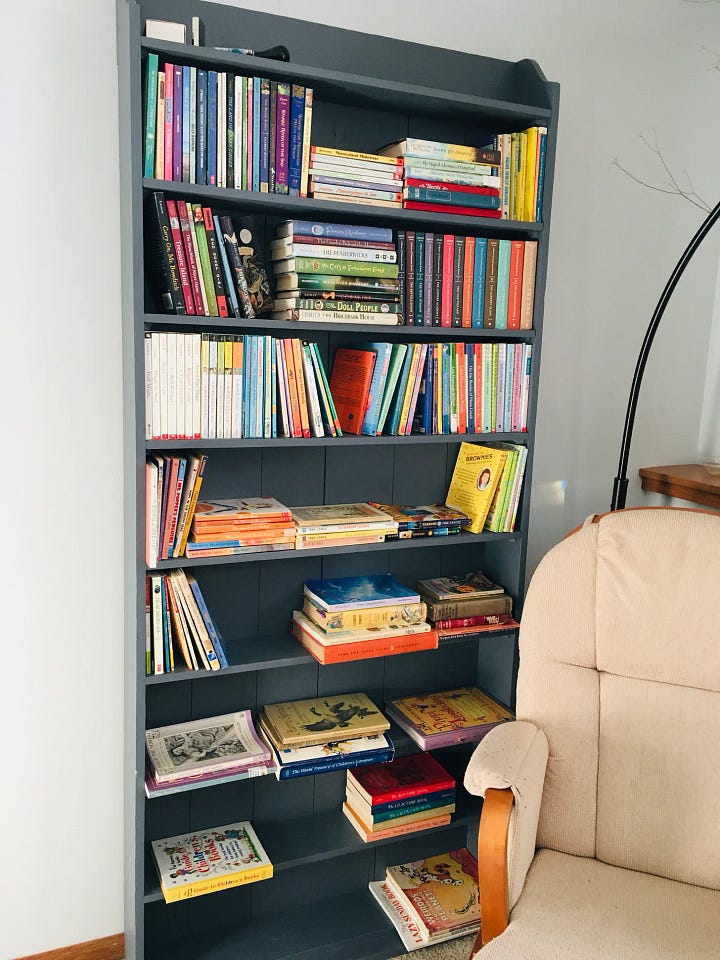
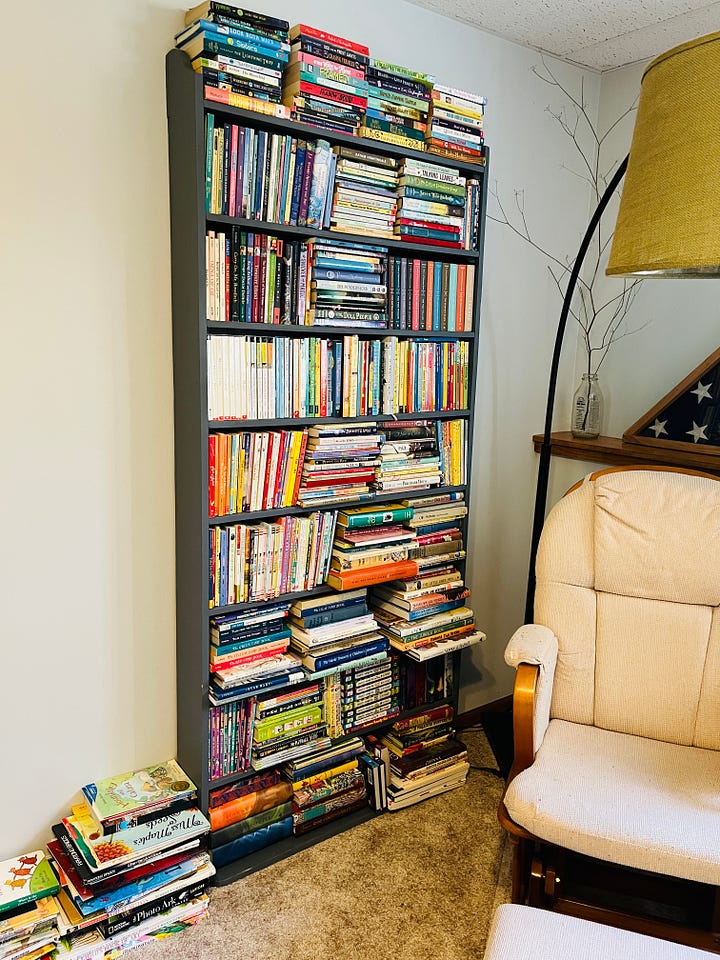
👆🏻 This is my last shelf, in the guest room on our lower level — added because, uh, I need more places to keep books. This is where I keep chapter books I buy that we’re either close-but-not-quite-ready to read yet, or years away from reading. None of these rotate, because storage.
👆🏻 On the most practical type of storage, all hail the humble plastic container. I have mentioned my seasonal book bins over the years, and this is an example of one. I have seven of these: one each for winter, Valentine’s Day, Easter/spring, summer, Halloween, fall/Thanksgiving, and Christmas. I store these in my guest room closet (a walk-in that is a no-go zone for my kids, as it is the locus of my magic-making, kind of if Santa’s workshop was the size of a small bathroom and without power tools). When I receive a package with one of those tiny silica gel desiccant packets inside, I slip one into my bins. Plastic storage boxes are truly excellent at keeping books clean and fresh even when I only take them out once a year, but I’m comforted by extra moisture control 😂
For more photos of what this used to look like, see my issue on seasonal book routines. This is what it looks like now:
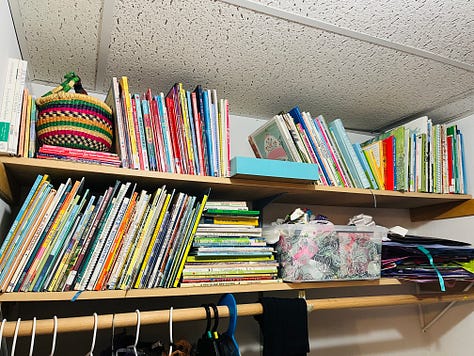

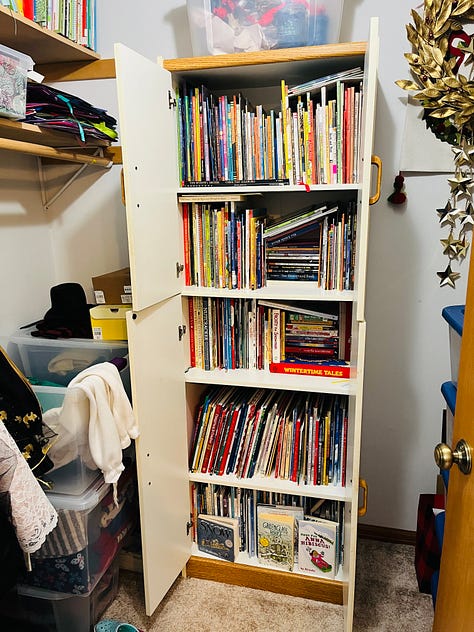
I ended up pulling out all of the books from each seasonal bin…because each collection outgrew its bin. Everything is organized by the same seasons and holidays. One photo is of shelves near the ceiling and the others — well, yes, I did put a full-sized cabinet in there (thank you, Goodwill).
My husband said, “You know, normal people don’t need a full-sized cabinet — or a cabinet of any kind — in their closet just for books.” 🤔 Point taken, dear, but fully ignored.
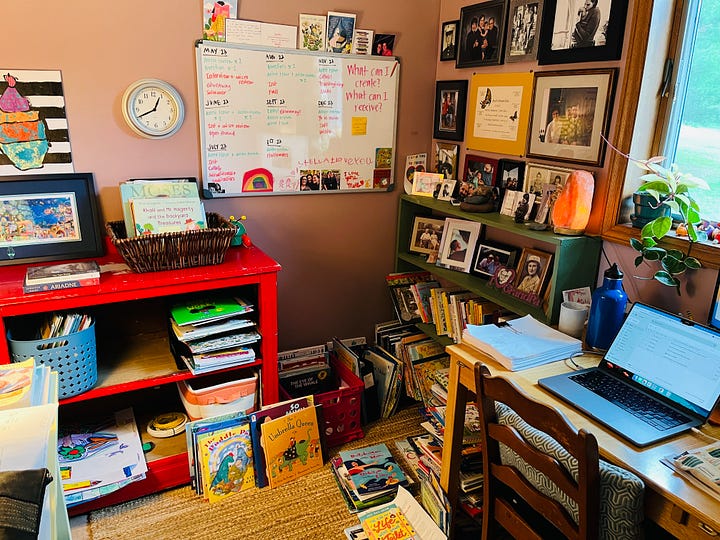
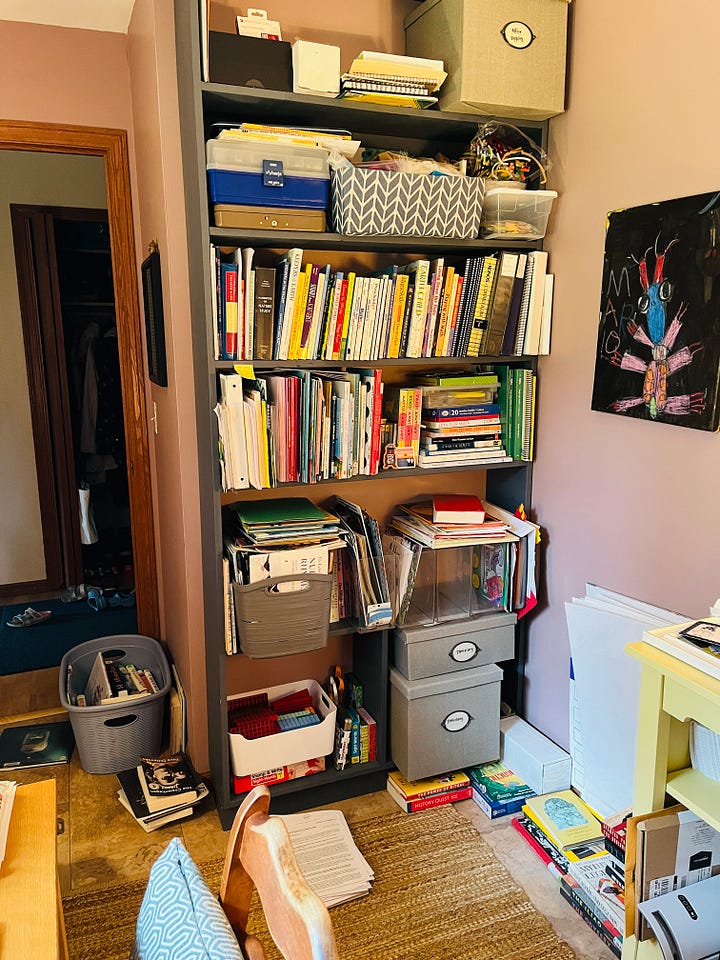
👆🏻 The last book tornado place in my house is my office, and I seriously debated about whether to even take a photo of this, because it feels like showing you my underwear. Yes, this is what it really looks like — this is even on a marginally organized day 😬
I am not a minimalist, as you can see, nor do I care all that much about, let’s say, aesthetics. This is where the magic of my brain — and this newsletter — happens. The books in here — well, on one side of the room, at least — are all books about children’s books, and books I plan to review, and books I’ve set aside for secret Can we read?-related projects that may or may not ever get started, much less finished.
On the other side of the room are the remains of our homeschool, which I still have not cleaned out two years later because what I am learning is that once you go down the path of learning at home, you kind of… never fully let go? and so I use books and resources and even curricula all the time still, just more casually and with a hell of a lot less self-induced pressure and stress.
(Since writing this I’ve changed it around completely — cleaning and redoing it, but that will have to be another post for another day.)
Today’s takeaways, or some things to consider:
Think about where you keep your books and how your storage serves you (or not)…
Do you have a system, and does it work?
Do you rotate books? If so, how often? If not, why not?
How accessible are your children’s books? Do they browse on their own? Do they sit down and page through what’s on offer?
How (and how often) do you provide new/fresh titles?
Is there a way you can incorporate book storage into your house/life that would make your routine easier? Is there a change you could make to anything that would simplify things?
Think about the places and spaces in your home that you have created for reading…
Do you have any reading nooks? Have they varied with your children’s needs? How cozy are they? Would you want to read there?
What do you have around your house that you can use or repurpose to create a reading nook?
If not, is there a spot you can create one?
In Books Children Love, Elizabeth Wilson writes:
“To be at home with books, children need book-loving homes.”
It has taken me years to amass our collection of books (I have also written about buying books, if you want to read every nitty gritty detail) and to figure out how to manage it all in a way that doesn’t make me feel overwhelmed or crazy. I have built nooks little by little, mostly with what we already have. My house is never super tidy. But it is, at the very least, a book-loving home. Storage matters, but it doesn’t matter more than that.
Whatever it all looks like, however you do any of this, what’s important is loving books and sharing that with your kids.
Sarah
👋 Did you know I have lots of other resources like this one?
Check out any or all of the issues below — which are structured just like this one — to help you build a culture of reading in your home:

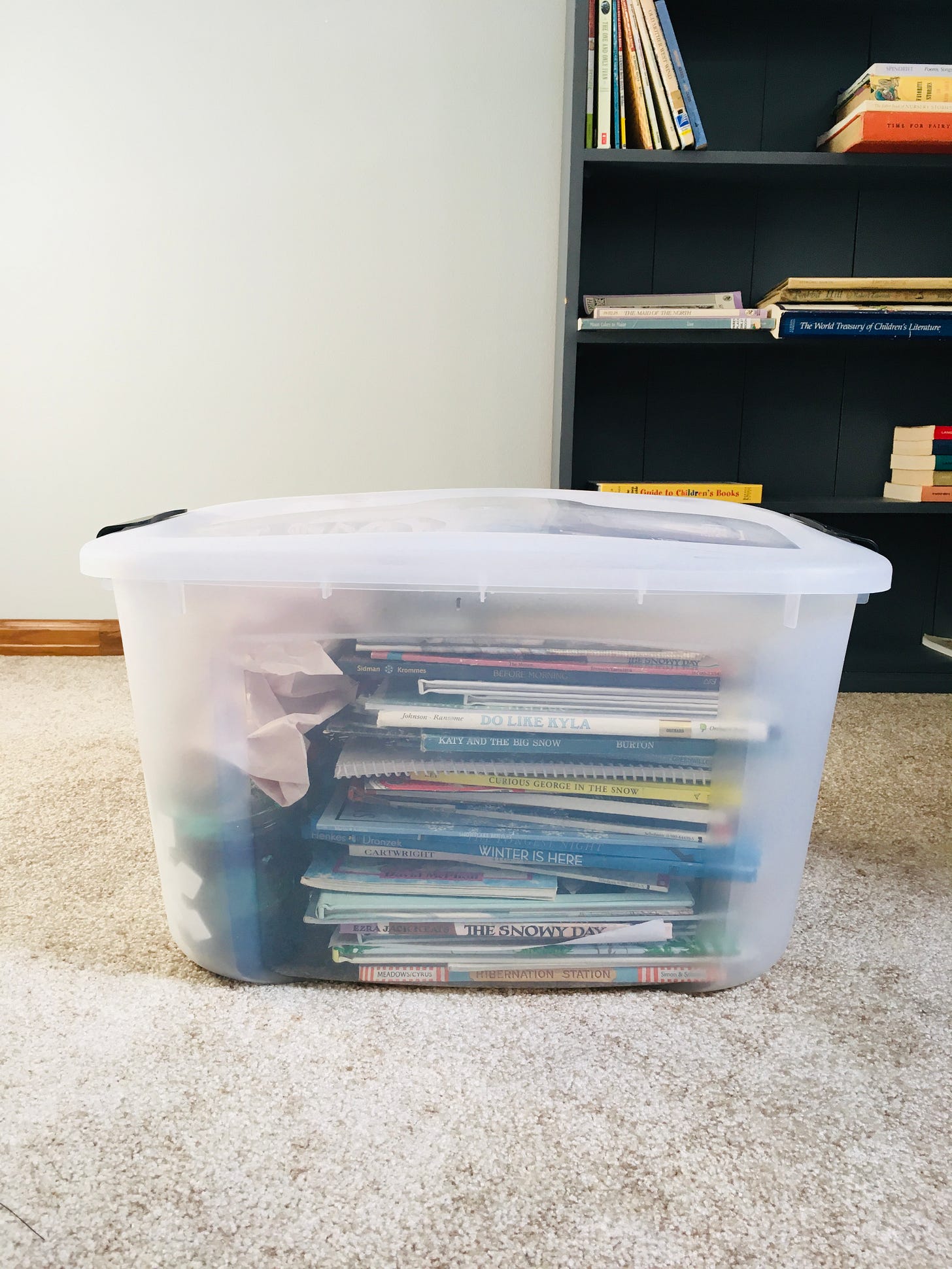
Thank you for showing us your underwear!🤣 Seriously--this is real life, and I love this way more than those photos by influencers on IG lounging on the pristine white shag rug in front of a stone fireplace with a few color-coordinated books on the shelf next to it. You re winning in my book!
Just looking at the photos makes me feel like I've been to the library or a good book store. Gah! I'm so happy you've documented (and updated).